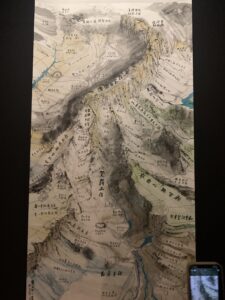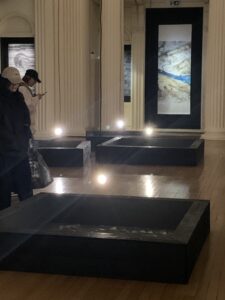
Using Qiu’s work as an example, I think a viewer who is not familiar with Chinese would naturally see the dense text in his work as some kind of pattern/texture in the painting and would be more concerned with the overall feeling of the work in terms of colour composition and so on. But if one is familiar with the language, one will naturally focus on the textual information, and I will always try to read the small text before understanding the work as a whole.

Proper display way is an essential part of the presentation of the work, and its role is not simply to place the artwork in an empty gallery that can accommodate more people but to be part of the work’s narrative. Qiu’s exhibition space uses small overhead lights and ambient lighting to create a quiet ambiguity. This is the same feeling expressed in his series, where the same regions at different times are linked or divided by disembodied literature and ideas. This connection and division were forged over a long time, in which many brutal events may have taken place but were eventually written on paper in just a few words.
When we visit the ancient battlefields, we can only imagine the brutality of war. Yet, because of the long history separating them, these brutalities can produce an ambiguous or literary beauty. The atmosphere of the whole gallery is not cold and stern; it makes me feel that the author is observing and recording history.
Is narrative in a gallery context different from your approach to narrative, and why?
In the gallery, it is essential to show how the work relates to the space. Over Christmas, I visited a ceramics exhibition at the Southbank Centre in London, where installation artist Lindsey mendick’s work till death do us part shows the microscopic conflicts and farces that litter family life, set up the entire room to immerse the viewer in some different scene of a home.



